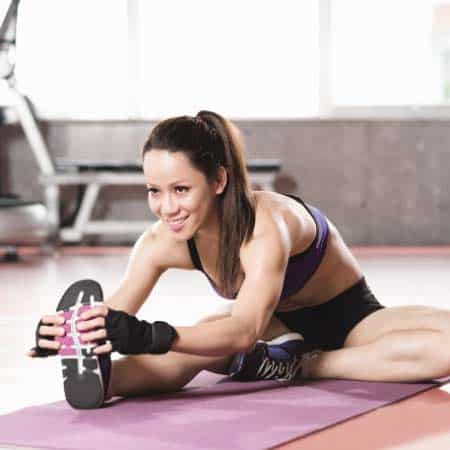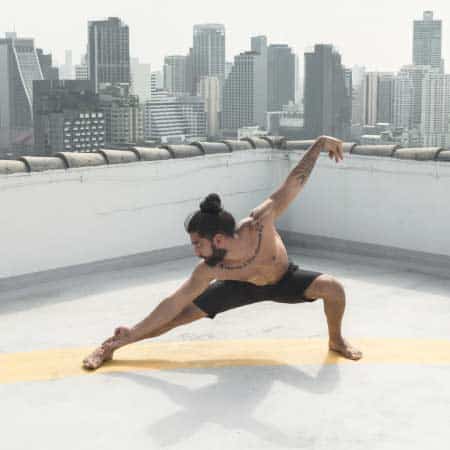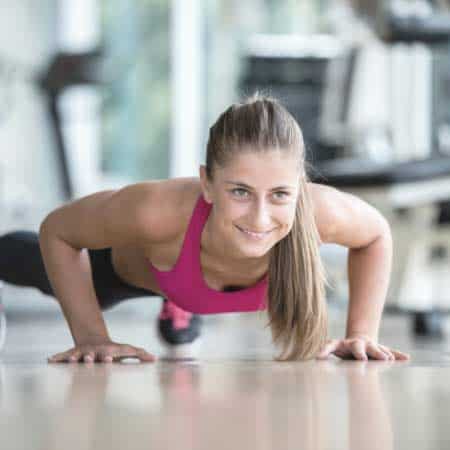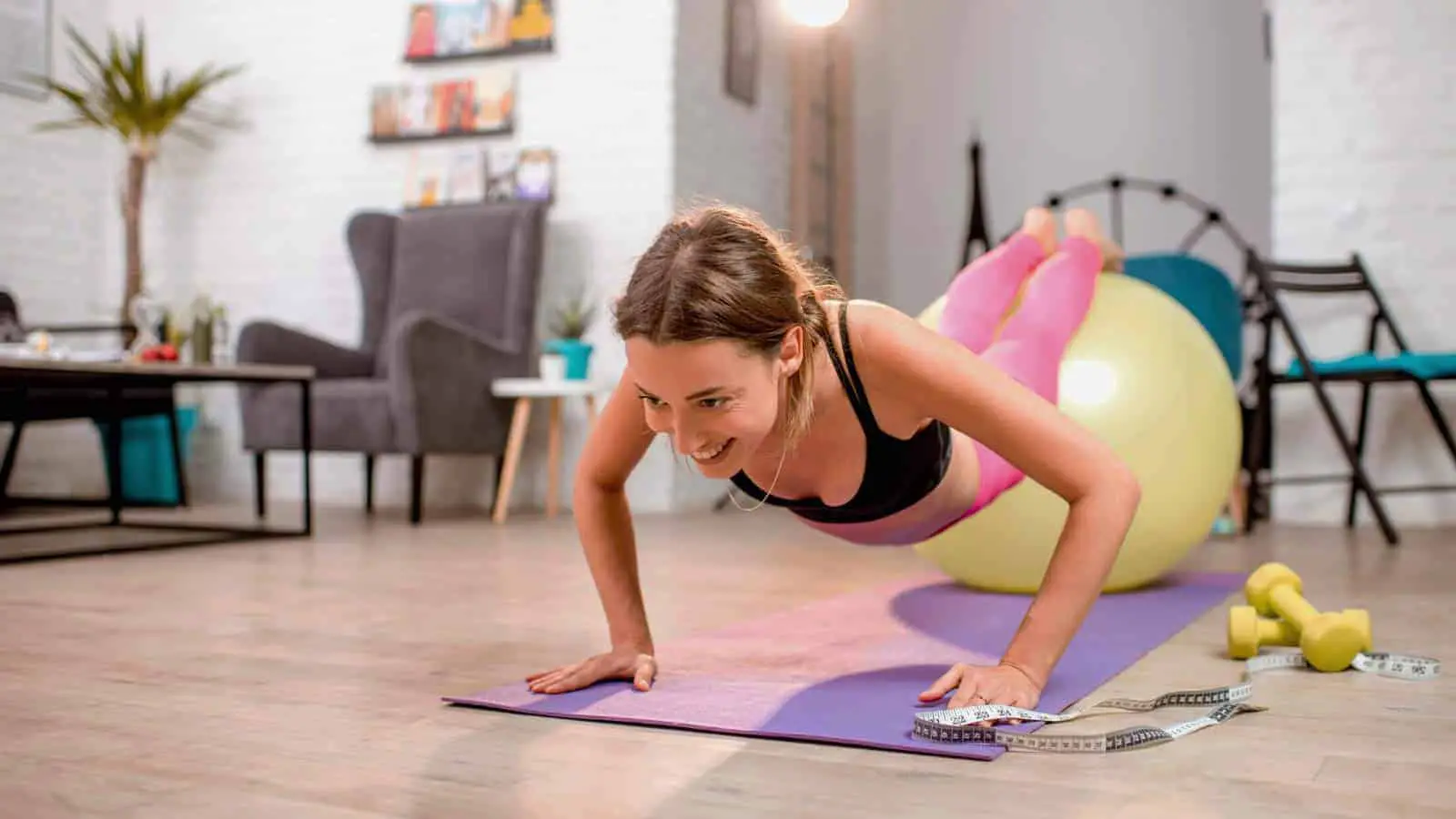Yoga mats are meant to be used during yoga specifically, but what about other forms of exercise? The great thing about yoga mats is that they’re versatile and can be used for more than just your yoga sessions. Yoga mats are excellent additions to many workouts.
Yoga mats are useful for exercise other than yoga because they provide a protective layer over wooden floors to protect them from damage, give users a cushion while performing stretches before and after workout, provide a non-slip surface during aerobic exercises, and provide a soft surface for high impact exercises.
Yoga mats are versatile tools for a workout, whether you’re doing yoga or some other exercise. There is often no need to put away your yoga mat or switch to another mat for non-yoga activities. In fact, yoga mats are quite beneficial for many exercises. Read on to learn about other ways you can utilize your yoga mat during a workout.
Yoga Mats Are Good for Protecting Wooden Floors from Weights
On a practical level, yoga mats are great to use during any exercise involving free weights over a wooden or tile floor. This is just a precaution in case one of the weights gets dropped on the floor. You’ll notice thick mats on the floor in the weight-lifting area if you go to the weight section in any gym. This is to protect the floors in case one of the weights is dropped during exercise.
Since yoga mats are thinner than the thick exercise mats used in gyms, they can’t protect against extremely heavy weights. If you exercise with heavy free weights, it’s a better idea to do so over a thicker mat. However, when you’re using light hand weights, placing down a yoga mat can help protect your wooden floors if your hands get slippery from sweat and you drop a weight.
If you use a yoga mat to protect your floor while lifting light weights, it’s recommended to invest in a few that you can lay down side by side to give yourself a larger area of protection. This way, you won’t feel restricted in your movements while you do your weight-based exercises.
If you’re working with heavy free weights, you might want to invest in heavier exercise mats for protecting the wooden floors in your home gym. Standard-sized yoga mats can only go so far.
Yoga Mats Are Good for Stretching Before and After Exercise
Along with protecting your floors, yoga mats are also great for stretching before and after exercise. Many stretches are best performed on the floor, and it is much more comfortable to do these stretches on a mat.

Stretching before and after exercise on a yoga mat yields the following benefits:
- Eases tension
- Reduces stress
- Increases flexibility of the skeletal system and joints
- Prevents muscle strain and injury
- Improves posture
- Calms the mind
- Increases energy
Stretching before and after exercise can still be done on the floor without a yoga mat, but it isn’t nearly as comfortable. It can be unsanitary to do exercises directly on the floor where people have been walking, especially if they’ve been walking in shoes. Yoga mats act as a protective barrier between you and the floor and can be sanitized between uses.
Using a yoga mat to place down for stretching before and after exercise is especially a good idea if you’re planning to do floor stretches in an area that usually has heavy foot traffic, such as the walkways of a gym. The contrast of the mat against the floor can help people see you sitting there and keep them from tripping over you if they aren’t paying attention.
Yoga Mats Provide a Soft Surface for High impact Exercises
Yoga mats can be used during exercise to provide a soft surface for high impact exercises that might otherwise cause injury to the joints. Here are some examples of some high impact exercises that would be better done on a yoga mat:
- Burpees
- Cross-training (such as jumping off pylon boxes or an exercise platform)
- Jumping jacks
- Knee-highs
High impact exercises can help people lose weight quickly, improve bone density, and take on a decent challenge if they’re already in pretty good shape. Unfortunately, they can be hard on the body if they aren’t done in a way that absorbs some of the impacts. That’s where yoga mats can come into play.
Doing high impact exercises places people at a higher risk for injury than low impact exercises, so yoga mats are a great way to reduce the chance of getting hurt doing one of these intense workouts. Yoga mats help provide some cushion for doing high impact work on the ground. They also provide a non-slip surface so you won’t be as likely to lose your balance and hurt yourself during an exercise.
High impact exercises are perfect for pushing your workout to the next level, but you’ll want to do them in a way that prevents injury that could sideline you from the gym for weeks. Instead, take the time to protect yourself from ergonomic injuries by employing tools like yoga mats to soften things up.
Yoga Mats Make Floor Exercises More Comfortable
Yoga mats are also an excellent choice for doing floor exercises. There are many exercises, such as Pilates, that are done almost exclusively on the floor, as well as several types of bodyweight exercises. Here are a few types of floor exercises that can be made much more comfortable by using a yoga mat:
- Crunches
- Push-ups
- Planks
- Leg lifts
- Bodyweight bridges
- Back extensions
- Bird dogs
- Mountain climbers
Floor exercises are great for using your body weight to exercise, especially for your core muscles. But crawling around on your hands and knees on the bare floor can be uncomfortable and can take the fun out of your workout. You want to eliminate anything that decreases your motivation to hit the home gym, so a yoga mat can be a way of making things a little easier on your body.
Another advantage of using a yoga mat for floor exercises is that using it routinely can help train your brain to get into “workout mode.” By acting as a visual cue, the yoga mat will help train your brain to know that it’s time to start working out when you pull out your mat.
When You Should (and Should Not) Use a Yoga Mat for Exercise
Yoga mats can be useful for some exercises, but they aren’t suitable for every exercise. Here are a few activities that shouldn’t be done on yoga mats:

- Gymnastics: Gymnastics requires a lot of floor space and a very thick cushion to protect the gymnast from injury in the event of a fall. Yoga mats aren’t large enough or thick enough to handle this kind of exercise.
- Martial arts: While a large-sized yoga mat may be suitable for performing katas or other stationary martial arts forms, thicker exercise or gym mats are necessary for doing this kind of exercise when sparring is involved. People could potentially fall to the floor hard when sparring, and they need more cushioning than a yoga mat can provide.
For these exercises, you’ll need to use a thick mat that covers a large square area of the floor. There are gymnastics mats and exercise mats that are better suited for this purpose.
Yoga mats can be easily used for exercises other than yoga, but they tend to be better for activities with the following qualities:
- Stationary: Yoga mats aren’t that large, so they should ideally be paired with exercises that don’t take up a lot of space. For exercises that require more floor area, you may want to invest in a larger type of exercise mat. Stationary exercises include floor exercises like crunches, Pilates, and lunges.
- Low fall risk: Yoga mats aren’t thin enough to cushion a person in the case of a hard fall that could occur in more intense sports such as martial arts or gymnastics, so thicker exercise mats should be used in those exercises. Most yoga mats are only around a quarter of an inch thick unless you look for a thicker type, which isn’t thick enough for harder falls.
- Need a non-slip surface: Some exercises are difficult to perform without a non-slip surface, especially those where you must leverage your body weight against the floor in an awkward position. Yoga mats are great for exercises like this since they can help a person stay firmly in place even as they change body positions.
Yoga mats are a terrific tool for many kinds of exercises, but it’s essential to know which exercises are safe to do with this type of mat and which exercises require a higher level of protection. If you don’t get a yoga mat that gives you enough protection, you might accidentally hurt yourself.
Are There Exercises That Should Not Be Performed on a Yoga Mat?
Many exercises are improved by using a yoga mat to help stabilize the body as you work, but there are also a couple of exercises where you shouldn’t involve a yoga mat. Don’t use a yoga mat for exercise in the following cases:
- Running on a treadmill: While it’s a good idea to put a mat underneath your treadmill to protect the floor and provide stability while running, a yoga mat is not suitable for this purpose. There are treadmill mats that do a much better job of absorbing the vibrations associated with a treadmill as well as reducing their noise output.
- Shadow yoga: Shadow yoga is a type of yoga that involves circular and non-linear movements, causing the person to venture off the yoga mat. This can cause the mat to get caught on the person’s feet as they move, distracting them during their yoga practice. For this type of yoga, it is often suggested to work without a mat.
Using a yoga mat for exercise is a good idea for many kinds of activities, but if it gets in your way while you’re trying to work out, you might want to give it a pass.
How to Choose a Yoga Mat for Exercise
If you want to use a yoga mat for yoga and other exercises, you may want to look into a yoga mat that is on the thicker side and a little larger. Larger yoga mats can still be used for yoga at home but are also suitable to do a more versatile range of exercises than the traditional yoga mat.
A standard rectangular yoga mat is a good option for doing yoga in a yoga studio where floor space is limited. However, if you want to do other exercises with your yoga mat, you could benefit from the extra space to move around without crossing over the barriers of the mat. You’ll also want to consider thicker yoga mats since thinner yoga mats don’t offer as much cushioning.
If you’re only using your yoga mat for yoga, you can get away with buying a smaller, thinner yoga mat that you can easily carry back and forth to gym classes with you. But if you want a yoga mat that can double as a mat for high impact and floor exercises, you’ll want to get a bit of an upgrade. That way, you’ll have plenty of room to work in comfort on the floor no matter what type of exercise you’re doing.
Can You Do Exercise Without a Yoga Mat?
Yoga mats are great for exercise, but is it possible to exercise (or do yoga) without them? The answer is yes, it’s possible to do exercise and do yoga without a yoga mat. Those people who are less sensitive to the hardness of the floor they’re working on and people who tend to do exercises that aren’t performed on the floor may not see the need for a yoga mat.
Many people do yoga on the carpet, grass, or other non-slip surfaces other than yoga mats, so you don’t need one for doing yoga at home. Yoga classes don’t require you to have a yoga mat to do yoga if you don’t have one, but they’ll often have yoga mats available to loan to you for the duration of your yoga session if you don’t want to invest in one.
Even though you can do exercises without a yoga mat, there are some risks involved, such as:

- Chance of falling: One of the benefits of a yoga mat is that it provides a non-slip surface to do exercise on, so without a yoga mat, you’ll need to do your exercises on some other type of non-slip surface to avoid the risk of falling. This is especially true if you’re exercising on a hard floor (such as a concrete foundation) since you’re more likely to get hurt falling on a hard surface.
- Less ergonomic: People may take the slight cushioning in their yoga mats for granted during exercise. Without this cushioning, high impact exercises may eventually take a toll on the joints of your elbows and knees.
- Cold floors: Yoga mats are especially useful for morning exercise during the cooler autumn and winter months when you might be hard-pressed to get down on the cold floor at six in the morning to get your crunches in. A yoga mat can provide an insulating barrier between you and the floor to prevent you from getting chilled.
- Less sanitary: Especially if you’re doing floor stretches in a gym or public area, getting down on a grimy floor without a mat can expose you to germs and illness when you otherwise don’t have to. Yoga mats are easy to wipe down between exercises to keep them clean and sanitary.
There are plenty of exercises, such as running or weight matches, that you can easily do without a yoga mat. Still, it’s a good idea to have one around for simple floor exercises, too, since these bodyweight exercises are convenient to perform when the weather is too poor for outdoor exercise or when you’re too busy to hit the gym.
Can yoga mats be used for exercise: Ergonomics and Safety During Exercise
For almost all home exercise routines, a good yoga mat can make your routine more comfortable, making you more enthusiastic about getting your workout done in the process. Yoga mats also provide safety through cushioning and a non-slip surface to make your workouts safer. No matter which yoga mat you end up choosing, you can’t go wrong with adding one to your gym supplies.




